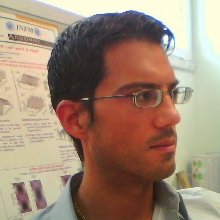Spin Waves in Magnonic Crystals and Hybrid Ferromagnetic Structures
A special issue of Magnetochemistry (ISSN 2312-7481). This special issue belongs to the section "Magnetic Materials".
Deadline for manuscript submissions: 31 December 2024 | Viewed by 2646
Special Issue Editor
Special Issue Information
Dear Colleagues,
In the last decade, the increasingly compelling need for alternatives to the electric current in information technology (IT) has raised interest regarding spin waves (SWs), which do not involve charge transfer and hence are promising ultra-low-dissipation information carriers. Since SWs have nanometric wavelengths in the GHz range (of IT interest), they can be manipulated at the nanoscale in suitably designed nanostructured periodic lattices (Magnonic Crystals) through Bragg diffraction. Their frequency/wavevector dispersions and hence propagation properties can be tailored by the choice of the lattice design and tuned by an external magnetic field. When associated with any ferroelectric layers, in multiferroic systems, such tunability might be enhanced by the possibility of a voltage-control over SW propagation (exploiting the inverse magnetoelastic effect between ferroelectric and ferromagnetic layers). A new source of degrees of freedom for controlling SW propagation consists of stacks of two or more ferromagnetic layers (Vertical Magnonics) with different geometries, from unpatterned films to lattices of different symmetry and element shape (Hybrid Magnonics), and in particular artificial spin ice (ASI) layers and artificial quasi-crystals (AQCs). ASI lattices and AQCs offer a variety of different stable configurations in any given field, based on the vertex frustration offered by the topology of the specific structure. The static and dynamic interplay among such layers, even with very different geometries, is believed to introduce new concepts to the issue of SW propagation.
The aim of this Special Issue is to collect experimental investigations ranging from sample fabrication and characterization issues to any static or dynamic measurements (MOKE loops, FMR spectra, Brillouin light scattering measurements, etc.), and at the same time to present the most relevant theoretical models and micromagnetic simulations performed not only to interpret experiments, but also to predict and unveil any subtle dynamic effects or new regularities emerging out of the complexity itself of the systems. Future applications of SW computing, interferometry, sensing and logic devices are also definitely welcome.
Dr. Federico Montoncello
Guest Editor
Manuscript Submission Information
Manuscripts should be submitted online at www.mdpi.com by registering and logging in to this website. Once you are registered, click here to go to the submission form. Manuscripts can be submitted until the deadline. All submissions that pass pre-check are peer-reviewed. Accepted papers will be published continuously in the journal (as soon as accepted) and will be listed together on the special issue website. Research articles, review articles as well as short communications are invited. For planned papers, a title and short abstract (about 100 words) can be sent to the Editorial Office for announcement on this website.
Submitted manuscripts should not have been published previously, nor be under consideration for publication elsewhere (except conference proceedings papers). All manuscripts are thoroughly refereed through a single-blind peer-review process. A guide for authors and other relevant information for submission of manuscripts is available on the Instructions for Authors page. Magnetochemistry is an international peer-reviewed open access monthly journal published by MDPI.
Please visit the Instructions for Authors page before submitting a manuscript. The Article Processing Charge (APC) for publication in this open access journal is 2700 CHF (Swiss Francs). Submitted papers should be well formatted and use good English. Authors may use MDPI's English editing service prior to publication or during author revisions.
Keywords
- spin waves
- magnonic crystals
- artificial spin ice
- artificial quasi-crystals
- nanomagnetism





